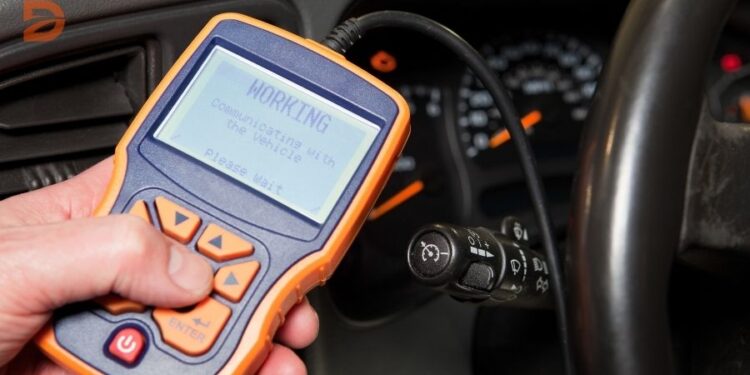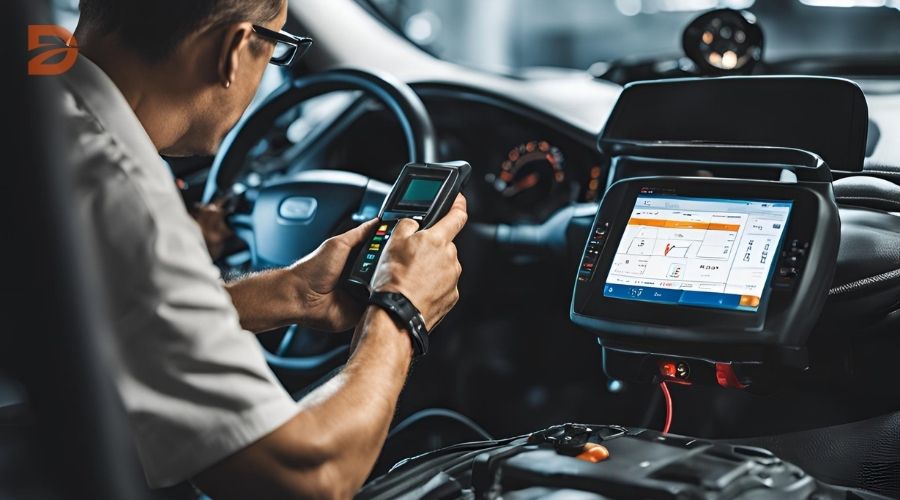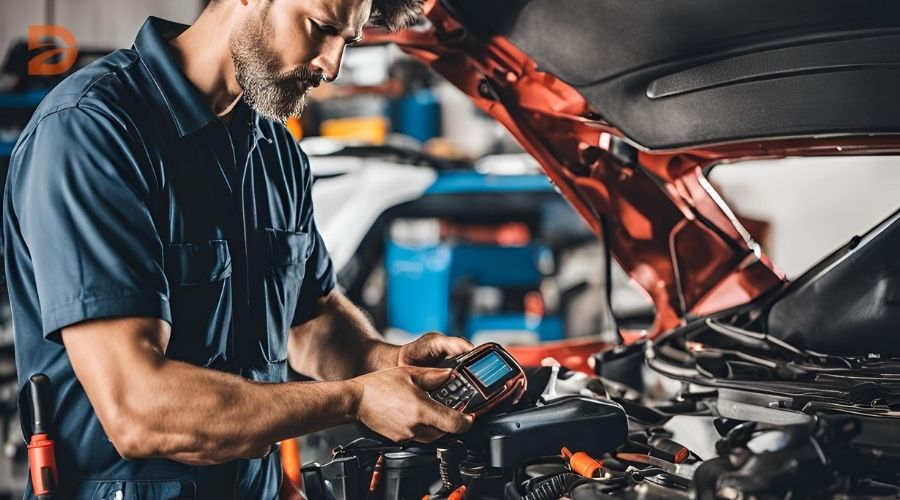Are you tired of paying hefty repair bills every time your car’s check engine light comes on? Discovering the top OBD-II scanners for DIY car diagnostics can help you save money and time by troubleshooting your vehicle’s issues at home with reliable tools. OBD-II scanners, once expensive luxuries exclusive to mechanics, are now affordable for every driver’s toolbox. These devices can read engine fault codes, clear diagnostic trouble codes, and provide valuable insights to diagnose and repair common automotive problems.
Key Takeaways
- OBD-II scanners are essential for reading diagnostic trouble codes (DTCs) stored on a car’s computer system.
- DIY diagnostics using OBD-II scanners can save money over professional tests that may be more expensive.
- OBD-II scanners contribute to increased safety by providing accurate diagnostics for warning lights, such as ABS sensor faults.
- Regular use of car fault scanners can help spot potential issues early and prevent them from escalating into larger, costlier repairs.
- Top-rated OBD-II scanner brands include BlueDriver, Fixd, Ancel, Topdon, OBDLink, and Panlong.
Introduction to OBD-II Scanners
The advent of onboard diagnostics (OBD) has revolutionized the way we maintain and troubleshoot our vehicles. At the heart of this revolution are OBD-II scanners, versatile tools that have become essential for any car owner or automotive enthusiast. These scanners unlock a wealth of information about your vehicle’s health, empowering you to take control of your car’s maintenance and repair process.
What is an OBD-II Scanner?
An OBD-II scanner is a diagnostic device that plugs into your vehicle’s onboard computer system, known as the Engine Control Unit (ECU). This connection allows the scanner to communicate with the ECU, retrieving and interpreting the diagnostic trouble codes (DTCs) stored within. These codes provide valuable insights into potential issues, ranging from malfunctioning sensors to more complex engine problems.
Why You Need an OBD-II Scanner
Owning an OBD-II scanner is a game-changer for anyone who wants to take a more active role in their car’s maintenance. These tools offer a wealth of benefits, including the ability to:
- Diagnose and clear engine trouble codes
- Monitor real-time vehicle data, such as engine performance and emissions levels
- Perform pre-purchase inspections and identify potential issues before buying a used car
- Troubleshoot problems and determine the root cause before visiting a mechanic
- Save money by avoiding unnecessary trips to the repair shop
With an OBD-II scanner in your toolbox, you can take a more proactive approach to car maintenance, saving time and money while ensuring your vehicle remains in top condition.
Top Picks for the Best OBD-II Scanners
When it comes to diagnosing and troubleshooting car issues, having the right OBD-II scanner can make all the difference. Our top picks for the best OBD-II scanners include the Innova 6100P, Topdon TopScan, and Launch CR529, each excelling in their respective categories to cater to the diverse needs of drivers and mechanics.
Innova 6100P – Best Overall OBD-II Scanner
The Innova 6100P, priced at $140, is the standout choice as the best overall OBD-II scanner. This feature-rich device boasts a range of professional-level capabilities, including live data display, predictive maintenance tools, and detailed repair instructions. With its 2.8-inch color display and 1-year warranty, the Innova 6100P makes DIY diagnostics a breeze.
Topdon TopScan – Best Mobile OBD-II Scanner
For those seeking a compact and wireless solution, the Topdon TopScan is the best mobile OBD-II scanner. Connecting via Bluetooth, this scanner offers unique performance indicators, live data capability, and the ability to estimate a car’s horsepower and torque. Priced at under $200 with a 2-year warranty, the Topdon TopScan is a versatile choice for on-the-go diagnostics.
Launch CR529 – Best Cheap OBD-II Scanner
On a tighter budget? The Launch CR529, priced at just $38, is the best cheap OBD-II scanner. Despite its low cost, this scanner provides lifetime updates, and live data display, and is an inexpensive option for DIY enthusiasts. With an 8-key interface and a 1-year warranty, the Launch CR529 delivers impressive value for money.
Key Features to Look for in an OBD-II Scanner
When selecting an OBD-II scanner, there are several key features to consider that can greatly enhance your vehicle diagnostics experience. From compatibility with your car’s make and model to the ability to read and clear diagnostic trouble codes, these specifications can make all the difference in efficiently identifying and resolving automotive issues.
Compatibility with Different Vehicle Makes and Models
Compatibility is a crucial factor when choosing an OBD-II scanner. Not all scanners are designed to work with every vehicle make and model, especially when dealing with older or more specialized cars. Ensure the scanner you select is compatible with your specific vehicle to avoid frustration and ensure accurate diagnostics.
Bluetooth Connectivity for Wireless Operation
Bluetooth connectivity is a valuable feature in modern OBD-II scanners. This wireless capability allows you to pair the scanner with your smartphone or tablet, providing a more convenient and clutter-free diagnostic experience. With Bluetooth, you can access the scanner’s functions and data remotely, making it easier to maneuver around the vehicle while troubleshooting.
Ability to Read and Clear Diagnostic Trouble Codes
The fundamental purpose of an OBD-II scanner is to read and interpret diagnostic trouble codes (DTCs) from the vehicle’s onboard computer. Look for a scanner that can not only retrieve these codes but also provide clear explanations and guidance on how to resolve the underlying issues. The ability to clear codes is also essential, allowing you to reset the system after addressing the problems.
| Feature | Importance | Description |
|---|---|---|
| Vehicle Compatibility | High | Ensure the scanner works with your specific make and model of vehicle, especially for older or specialized cars. |
| Bluetooth Connectivity | Medium | Wireless operation through Bluetooth pairing with your smartphone or tablet can enhance convenience and mobility. |
| Diagnostic Trouble Code (DTC) Reading and Clearing | High | The core function of an OBD-II scanner is to read and interpret DTCs, as well as clear them after addressing issues. |
OBD-II scanners, car diagnostics
OBD-II scanners have become an essential tool for DIY car enthusiasts and professional mechanics alike. These devices allow you to diagnose a wide range of automotive issues by communicating with your vehicle’s onboard computer and retrieving diagnostic trouble codes. With an OBD-II scanner, you can save time and money by troubleshooting problems yourself instead of relying on a mechanic. From reading engine fault codes to resetting service lights, these versatile tools are a must-have for anyone who wants to maintain and repair their vehicle more cost-effectively.
One of the key benefits of OBD-II scanners is their ability to provide detailed information about your car’s performance and health. These scanners can retrieve diagnostic trouble codes that pinpoint the source of problems, allowing you to identify and address issues quickly. Whether you’re dealing with a check engine light, transmission issues, or any other automotive concern, an OBD-II scanner can be your first line of defense in diagnosing and resolving the problem.
For DIY car enthusiasts, OBD-II scanners offer a unique opportunity to take control of their vehicle’s maintenance and repair. By using these tools, you can gain a deeper understanding of how your car functions and learn to troubleshoot common problems on your own. This not only saves you money on costly mechanic fees but also empowers you to become a more knowledgeable and self-sufficient car owner.
In addition to their diagnostic capabilities, many OBD-II scanners also offer advanced features, such as the ability to read and clear diagnostic trouble codes, access live data streams, and perform system resets. These advanced functions can be particularly useful for professional mechanics who need to diagnose and repair complex automotive issues with precision and efficiency.
Whether you’re a DIY enthusiast or a professional mechanic, investing in a high-quality OBD-II scanner can be a game-changer when it comes to automotive troubleshooting and repair. With the right tool, you can take control of your vehicle’s health, save money, and gain a deeper understanding of how your car operates.
User-Friendly Design and Interface
When choosing an OBD-II scanner, the design and user interface are crucial considerations. The best scanners feature intuitive menus, clear displays, and straightforward controls that make it easy for both DIY enthusiasts and professional mechanics to navigate and use the device effectively. A user-friendly interface can streamline the diagnostic process and ensure you get the information you need quickly, without getting bogged down in complex menus or features.
Prioritizing scanners with a clean, ergonomic design and logical layout will enhance your overall experience and maximize the value of these essential automotive tools. Look for features like:
- Intuitive menu structure and navigation
- Large, high-resolution displays for easy reading
- Responsive and tactile buttons or touchscreens
- Convenient data storage and sharing capabilities
- Compatibility with mobile apps for seamless diagnostics
By focusing on OBD-II scanner design and ease of use, you can find a tool that fits your needs and simplifies the often-complex process of diagnosing and troubleshooting vehicle issues. A user-friendly interface can mean the difference between a frustrating experience and a straightforward, efficient one, making it a crucial factor to consider when selecting the right OBD-II scanner for your needs.
Advanced Capabilities of High-End OBD-II Scanners
While basic OBD-II scanners can read and clear diagnostic trouble codes, the more advanced models offer a range of enhanced features that cater to both DIY enthusiasts and professional mechanics. These high-end scanners often provide live data streaming and graphing, allowing you to monitor real-time sensor readings and engine performance data in detail.
Live Data Streaming and Graphing
With live data streaming, you can view and analyze the behavior of various vehicle components and systems as they operate. This can be particularly useful for identifying intermittent issues or monitoring the effects of troubleshooting steps. The ability to graph this live data further enhances the diagnostic process, enabling you to visualize trends and patterns that may not be immediately apparent from raw numerical readings.
Access to Freeze Frame Data
Another advanced capability of high-end OBD-II scanners is the ability to access freeze frame data. This feature captures the vehicle’s state at the precise moment a trouble code was set, providing valuable insights into the conditions that led to the problem. By analyzing this data, you can better understand the root cause of the issue and develop a more targeted repair strategy.
Predictive Maintenance and Repair Suggestions
The most sophisticated OBD-II scanners even include predictive maintenance and repair suggestion features. These tools can analyze the vehicle’s performance data and identify potential issues before they escalate, helping you anticipate and address problems proactively. Some advanced scanners may even provide recommendations on the necessary parts and repairs required, further streamlining the diagnostic and repair process.
These advanced OBD-II scanner features demonstrate the continued evolution of automotive diagnostics, empowering both DIY enthusiasts and professional mechanics with more comprehensive tools to diagnose and maintain their vehicles effectively.
Choosing the Right OBD-II Scanner for Your Needs
When it comes to selecting the perfect OBD-II scanner for your automotive needs, it’s essential to consider your level of expertise and the specific requirements of the task at hand. Whether you’re a seasoned professional mechanic or a passionate DIY enthusiast, the right scanner can make all the difference in streamlining your car maintenance and repair efforts.
Considerations for Professional Mechanics
For professional mechanics, an advanced OBD-II scanner with a comprehensive set of features is often the preferred choice. These high-end diagnostic tools, like the Foxwell NT710 or Foxwell NT809BT, offer a wealth of capabilities, including live data streaming, freeze-frame data access, and even predictive maintenance recommendations. With the ability to support over 50 car brands and 10,000+ models, professional-grade scanners provide the depth of coverage and precision required for efficient automotive diagnostics and repairs.
Recommendations for DIY Enthusiasts
For DIY enthusiasts, more affordable and user-friendly OBD-II scanners, such as the Foxwell NT530 or Foxwell NT650 Elite, can still deliver impressive performance. These scanners, while less comprehensive than their professional counterparts, are well-suited for basic diagnostics, trouble code reading and clearing, and even maintenance services. With compatibility spanning from 1999 models to the latest 2022 vehicles, these scanners offer an accessible and reliable solution for home mechanics and car enthusiasts.
Regardless of your level of expertise, choosing the right OBD-II scanner comes down to evaluating your specific needs, budget, and the features that will best support your automotive diagnostics and repair efforts. By carefully researching and comparing the available options, you can find the perfect tool to take your car maintenance and troubleshooting to the next level.
| Scanner Model | Compatibility | Key Features | Intended User |
|---|---|---|---|
| Foxwell NT710 | Over 50 car brands and 10,000+ models | Full system diagnosis, over 30 reset functions | Professional Mechanics |
| Foxwell NT809BT | Supports vehicles from 1999 to 2022 | Android 9.0 with 7″ touchscreen, bi-directional control | Professional Mechanics |
| Foxwell NT530 | Supports vehicles from 1999 to 2022 | Basic diagnostics, trouble code reading, and clearing | DIY Enthusiasts |
| Foxwell NT650 Elite | Supports vehicles from 1999 to 2022 | Over 25 maintenance services | DIY Enthusiasts |
Conclusion
OBD-II scanners have become an essential tool for anyone who wants to take a more active role in maintaining and repairing their vehicle. These diagnostic devices provide the means to read engine fault codes, clear trouble codes, and gain valuable insights into your car’s performance and health. By investing in a reliable OBD-II scanner, you can save time and money on car repairs, troubleshoot issues on your own, and even stay ahead of potential problems before they become major headaches.
Whether you’re a professional mechanic or a DIY enthusiast, an OBD-II scanner is a must-have addition to your automotive toolbox. These scanners have revolutionized car diagnostics, making maintenance and repairs more accessible to both experts and enthusiasts alike. With features like live data streaming, freeze frame data access, and predictive maintenance suggestions, high-end OBD-II scanners can empower you to take control of your car’s health and avoid costly repairs down the line.
As you navigate the world of OBD-II scanners, it’s important to consider factors like compatibility, connectivity, and user-friendliness to ensure you find the right tool for your specific needs. By understanding the key features and capabilities of these scanners, you can make an informed decision and unlock the full potential of OBD-II technology to keep your vehicle running smoothly and efficiently.
FAQ
What is an OBD-II scanner?
An OBD-II scanner is a device that connects to a vehicle’s onboard computer to communicate and retrieve diagnostic information. These tools can read and clear engine fault codes, provide live data monitoring and help identify issues before they become major problems.
Why do I need an OBD-II scanner?
Having an OBD-II scanner in your toolbox is essential for any driver who wants to save time and money on car repairs by troubleshooting problems themselves instead of relying on a mechanic. These devices allow you to diagnose a wide range of automotive issues by communicating with your vehicle’s onboard computer and retrieving diagnostic trouble codes.
What are the best OBD-II scanners?
Our top picks for the best OBD-II scanners include the Innova 6100P, Topdon TopScan, and Launch CR529. The Innova 6100P is the best overall scanner, the Topdon TopScan is the best mobile scanner, and the Launch CR529 is the best budget option.
What features should I look for in an OBD-II scanner?
When choosing an OBD-II scanner, it’s important to consider key features like compatibility with your vehicle’s make and model, Bluetooth connectivity for wireless operation, and the ability to read and clear diagnostic trouble codes.
How do advanced OBD-II scanners differ from basic models?
High-end OBD-II scanners often feature live data streaming and graphing, access to freeze frame data, and predictive maintenance and repair suggestion features, which can provide valuable insights for diagnosis and troubleshooting.
How do I choose the right OBD-II scanner for my needs?
When selecting an OBD-II scanner, it’s important to consider your specific needs and level of expertise. Professional mechanics may require more advanced features, while DIY enthusiasts may be better served by more affordable, user-friendly scanners that can still handle basic diagnostics and troubleshooting.











